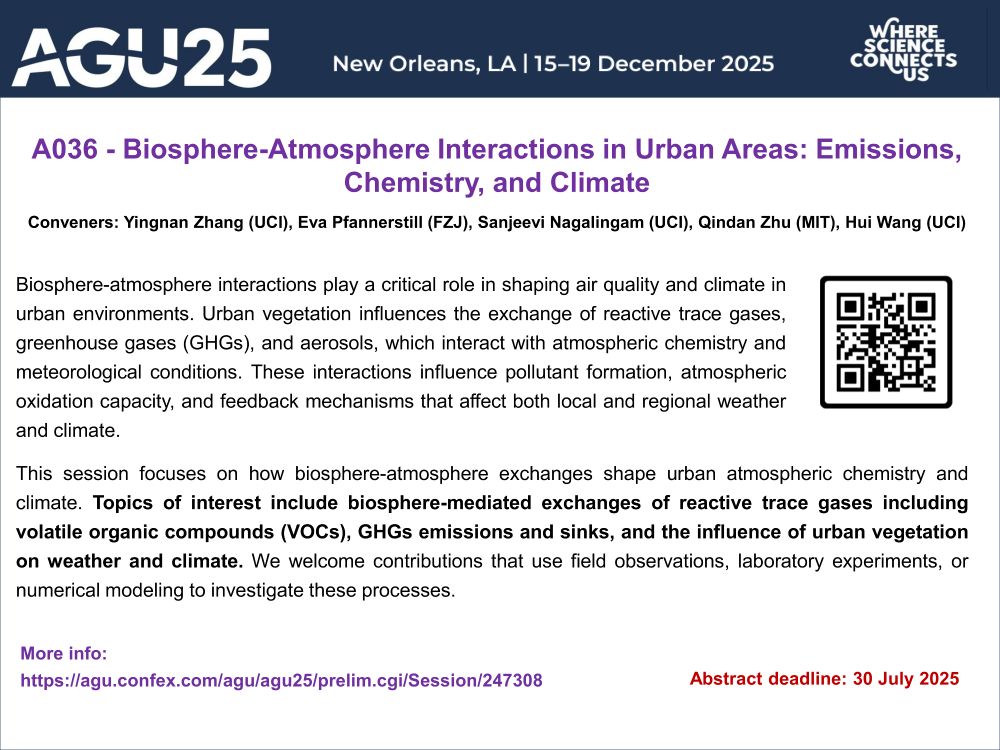Join our team! The UMN atmospheric chemistry group is recruiting a postdoc to collect and analyze airborne NH3 measurements as part of NASA FarmFlux.
See z.umn.edu/aw67 for details, & contact Julieta ([email protected]) and I ([email protected]) with questions!

Join our team! The UMN atmospheric chemistry group is recruiting a postdoc to collect and analyze airborne NH3 measurements as part of NASA FarmFlux.
See z.umn.edu/aw67 for details, & contact Julieta ([email protected]) and I ([email protected]) with questions!
❄️❄️❄️Microbial VOC Exchange in Arctic Glacier Ecosystems❄️ ❄️❄️
🌇Copenhagen, Denmark
The supervisor team includes @alexanesio.bsky.social, Anders Priemé & @riikkarinnan.bsky.social
employment.ku.dk/phd?show=165...
Deadline 15 November 2025.


❄️❄️❄️Microbial VOC Exchange in Arctic Glacier Ecosystems❄️ ❄️❄️
🌇Copenhagen, Denmark
The supervisor team includes @alexanesio.bsky.social, Anders Priemé & @riikkarinnan.bsky.social
employment.ku.dk/phd?show=165...
Deadline 15 November 2025.
We measured #VOC & #CO2 fluxes from 3 ponds in a peatland forest using floating chambers. Understanding of freshwater ecosystems as VOC sources is poor, so this work led by Y. Qin, published in #ASLO_LO provides important new data.
doi.org/10.1002/lno....
@dg.dk @voltcenter.bsky.social


We measured #VOC & #CO2 fluxes from 3 ponds in a peatland forest using floating chambers. Understanding of freshwater ecosystems as VOC sources is poor, so this work led by Y. Qin, published in #ASLO_LO provides important new data.
doi.org/10.1002/lno....
@dg.dk @voltcenter.bsky.social
@voltcenter.bsky.social is #hiring a #LabManager /Lab specialist. Are you familiar with PTR-TOF-MS and GC-MS? You'll coordinate lab&field activities, QC&calibration, solve problems, assist with tech installations, and provide tech support to researchers
employment.ku.dk/all-vacancie...

@voltcenter.bsky.social is #hiring a #LabManager /Lab specialist. Are you familiar with PTR-TOF-MS and GC-MS? You'll coordinate lab&field activities, QC&calibration, solve problems, assist with tech installations, and provide tech support to researchers
employment.ku.dk/all-vacancie...


doi.org/10.1111/gcb....
@voltcenter.bsky.social @dg.dk @villumfonden.bsky.social @globalchangebio.bsky.social

doi.org/10.1111/gcb....
@voltcenter.bsky.social @dg.dk @villumfonden.bsky.social @globalchangebio.bsky.social
Work on cutting-edge atmospheric instrumentation, with fieldwork in amazing locations like Cape Verde 🌍☁️
📅 Apply by 7th May 👉 jobs.cranfield.ac.uk/vacancy/rese...
@atmchemaerojobs.bsky.social #Postdoc #ScienceJobs
Work on cutting-edge atmospheric instrumentation, with fieldwork in amazing locations like Cape Verde 🌍☁️
📅 Apply by 7th May 👉 jobs.cranfield.ac.uk/vacancy/rese...
@atmchemaerojobs.bsky.social #Postdoc #ScienceJobs
+ nice colleagues @voltcenter.bsky.social
+ Copenhagen
+ competitive salary
+ good PhD program
employment.ku.dk/phd/?show=16...
Please repost!
+ nice colleagues @voltcenter.bsky.social
+ Copenhagen
+ competitive salary
+ good PhD program
employment.ku.dk/phd/?show=16...
Please repost!

villumfonden.dk/en/news/mill...
villumfonden.dk/en/news/mill...
PhD course on VOCs and isotope techniques.
In addition to stable isotope techniques to study VOC production, consumption and emissions, you will learn data processing & generally about VOCs in ecosystem processes.
phdcourses.ku.dk/DetailKursus...
3/3

PhD course on VOCs and isotope techniques.
In addition to stable isotope techniques to study VOC production, consumption and emissions, you will learn data processing & generally about VOCs in ecosystem processes.
phdcourses.ku.dk/DetailKursus...
3/3



Congratulations to our postdoc Yi Jiao!
pubs.acs.org/doi/10.1021/...

Congratulations to our postdoc Yi Jiao!
pubs.acs.org/doi/10.1021/...

go.shr.lc/3X1j8QX

go.shr.lc/3X1j8QX
www.pnas.org/doi/abs/10.1...

www.pnas.org/doi/abs/10.1...

